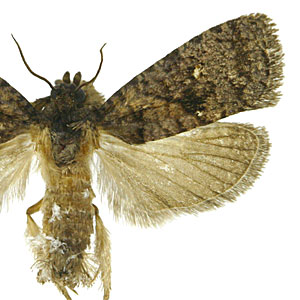Adult Recognition

FWL: 6.5-11.5 mm
Males are grayish brown with faint black reticulated markings. Females are uniformly darker with less markings. Both males and females have a conspicuous white dot on the distal one-third of the forewing. Hindwings are pale grayish brown.
Male genitalia are characterized by an elongate tapering uncus, densely setose socii, and subtriangular valvae. Female genitalia are characterized by broad papillae anales and two large signa in the corpus bursae. Males have two large patches of coremata on the posterior margin of segment VIII that are paired in two lengths.
The subgenus Cryptaspasma contains a total of six species, including C. bipenicilla, all of which are difficult to separate. Cryptaspasma bipenicilla can be separated from most described Neotropical Cryptaspasma (subgenus Cryptaspasma) by the two lengths of coremata on the male abdomen. Other undescribed species from Central and South America have two lengths of coremata but may be separated using a combination of other characters.
Larval Morphology

The larva of C. bipenicilla has not been described. Larvae of other species of Cryptaspasma are orange to pink with a yellowish brown head and prothoracic shield. Pinacula are weakly sclerotized. Diagnostic characters include: D2 setae on A8 on the same "saddle" pinaculum; D1, D2, and SD1 setae on A9 all on the same large "saddle" pinaculum; L pinaculum on A9 bisetose; and anal comb absent.
Biology

Life history information for C. bipenicilla is undocumented, although it is assumed to be similar to that of other avocado-feeding Cryptaspasma, such as Cryptaspasma perseana.
Host plants
Cryptaspasma bipenicilla has been recorded feeding on seeds of avocado and slugwood (Lauraceae) in Puerto Rico and Cuba. Potential lauraceous hosts in the southeastern U.S. include Persea borbonia (L.) (redbay) and Persea palustris Sarg. (swamp bay).
| Family | Genus/species | Common name |
| Lauraceae | Beilschmiedia pendula (Sw.) Hemsl. | slugwood |
| Lauraceae | Persea americana Mill. | avocado |
Distribution

Cryptaspasma bipenicilla has been reported from the southeastern United States (North Carolina to Texas), the Caribbean, and Central America.
References

Brown, J. W. and R. L. Brown. 2004. A new species of Cryptaspasma Walsingham (Lepidoptera: Tortricidae: Olethreutinae) from Central America, the Caribbean, and southeastern United States, with a catalogue of the world fauna of Microcorsini. Proceedings of the Entomological Society of Washington. 106: 288-297.
Gilligan, T. M., J. W. Brown and M. S. Hoddle. 2011. A new avocado pest in Central America (Lepidoptera: Tortricidae) with a key to Lepidoptera larvae threatening avocados in California. Zootaxa. 3137: 31-45.

